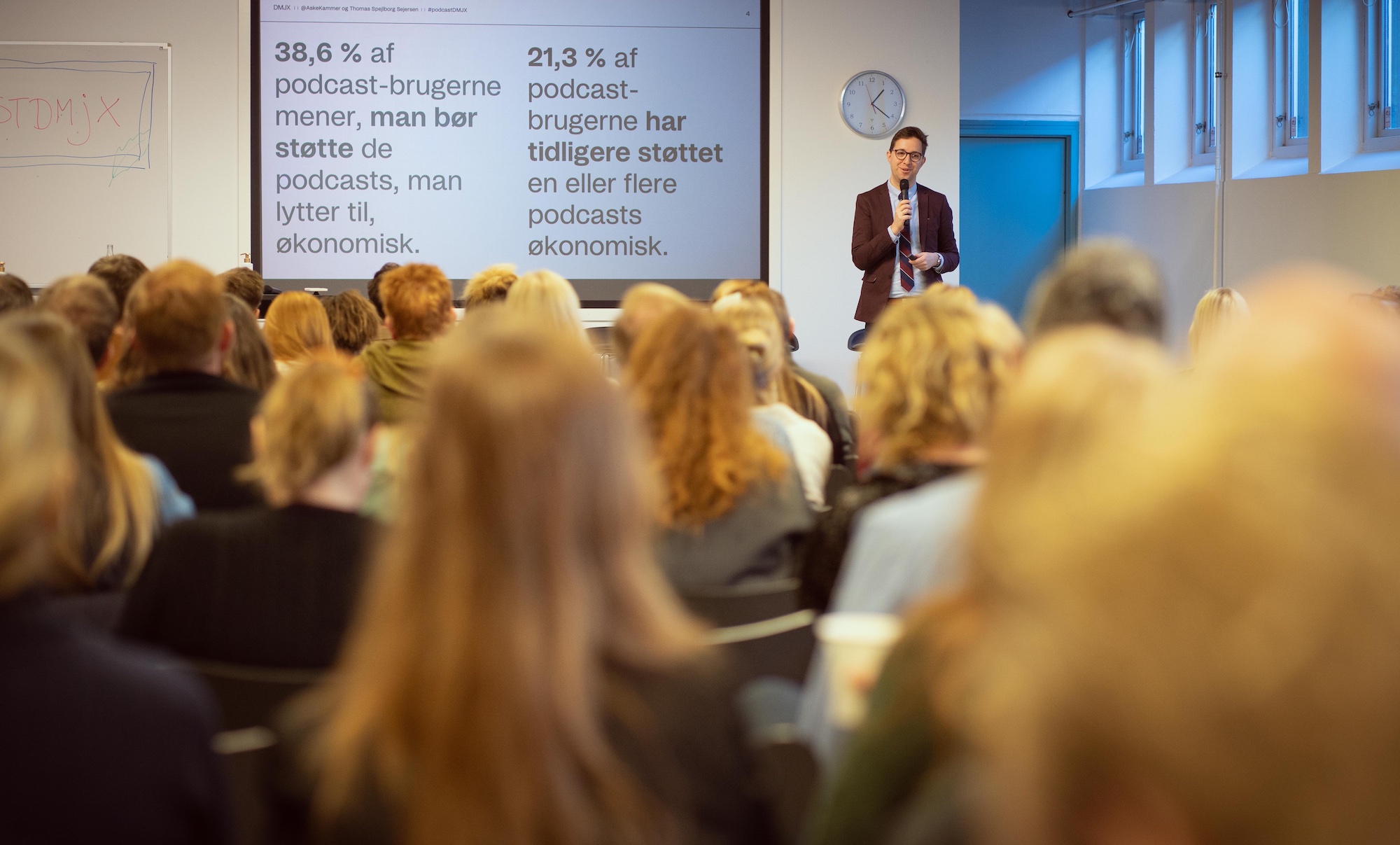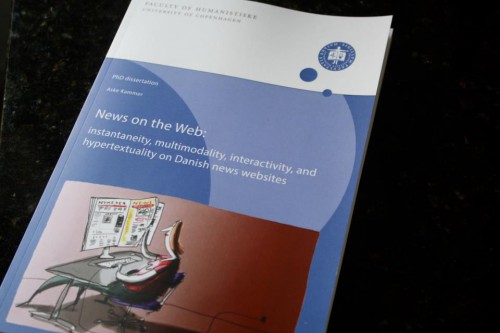What is the role of digital journalism in journalism education?
It is an important question, and it is one that I have discussed and thought about more than usually since yesterday. The occasion is an opinion piece by Signe Okkels on Journalisten.dk (the trade journal for Danish journalists) where she critiques the journalism study programs in Denmark for not taking the digital dimension serious even though the digital is probably here to stay. Okkels studied journalism at Roskilde University and her point of comparison is a nine-months program at University of Southern California. Her conclusion:
“The level of Danish journalism education must simply be improved, and that calls for a different prioritization of and attitude toward digital journalism.” (translated by me)
It would be easy to just dismiss the critique as anecdotal (“well, that’s just her experience”) and off the mark (what does Okkels know about the other journalism educations in Denmark, including the one I work at?). But I actually think that, to some degree, she has a point – and her piece certainly struck a chord among people in the news industry:
Kan kun give @SigneOkkels ret i dette. Jeg brugte 2 år med jour på SBCC i USA. SDU var en varmestue sammenlignet http://t.co/HSC04gcsYv
— Katrine Villarreal (@KV_Villumsen) September 14, 2015
@KV_Villumsen @SigneOkkels Den store udfordring er, at der rykkes så langsomt på noget, der er langt foran, når uddannelsen først er klar… — Heine Jørgensen (@heinekanten) September 14, 2015
Hvor er det her rigtigt. – til gengæld har der aldrig været bedre muligheder for at præsentere journalistik spændende http://t.co/Nr53S98cBn
— Gerd May (@GerdMay) September 14, 2015
@KV_Villumsen @heinekanten @AskeKammer @Linsedaugaard Jeg oplever også at kun få praktiksøgende har digitalt fokus. Meget, meget få. — Magnus Bjerg (@MagnusBjerg) September 14, 2015
@SigneOkkels @KV_Villumsen Enig. Men min erf. er, at pilen (også) peger den anden vej. Mange stud. viser/har ingen interesse for digi jour
— Pernille Holbøll (@Holboell) September 15, 2015
The people tweeting here are obviously ones who pay more attention to the digital and will likely place more emphasis on it than your average editor or journalist (for one thing, they discuss this matter on Twitter…). But that does not disqualify their points of view. On the contrary: they work with the tensions and conflicts that surround the digital in newsrooms on an everyday basis. They know what this is about. For that reason alone, it would be wrong for journalism educators to just discard Okkels’ piece.
I agree with much of what Okkels and her tweeting supporters say. At the journalism study programs, we can do better in integrating digital with everything we do. Or rather, we should stop treating digital as a distinct category and instead teach our students to work with writing, audio, and visuals across all media. Instead of teaching “television and radio”, we should teach “moving images and sound”. We should teach our students about emerging business models, social media skills, WordPress, scraping, and the basic principles of coding as integral parts of the existing curriculum. In many instances, we should get rid of the “digital” prefix – nobody talks about “analogue” or “electronic” journalism, right?
But the thing is – and this is where I respectfully disagree with Okkels’ assessment of current journalism education in Denmark – that we already do much of this. At least at the Centre for Journalism at SDU where I work; what the other institutions do, I cannot speak for. We do not do it all the time, and we do not do it everywhere. But in our “old” MA program, my “J-Lab” course on media innovation and concept development in a transformed media environment is now mandatory. And on the new MA program, which just started on September 1, digital is one of the three cornerstones: the students must make their own websites and publish on it, they learn to write and produce audio and video for whatever platform they choose, and they will spend half a year on a “digital project” in collaboration with media organizations. It is our explicit ambition that these students excel at being digital journalists when they graduate.
I do not mean to be self-congratulatory, because we are not there (wherever that may be) yet. Could we move faster? Yes. Should we move faster? Yes, I think so. Should we be more agile and adapt to changes faster than we do? Yes, of course.
It is one thing that universities are slow organizations with above-average institutional inertia. But Magnus Bjerg from Danish TV 2 raises an important issue in his tweet as does Pernille Holbøll from free daily MetroXpress: not very many students are actually all that interested in the digital. Their observation corresponds with my own experiences from teaching our students and what I hear from colleagues on other Danish universities. Sure, digital is fine and all, but what really matters is getting your byline on the front-page of the printed newspaper or in the evening news. In that context, it is sometimes uphill for educators who actually want to push things in a digital direction (but we can, of course, be better – I am not making excuses). That is also a serious challenge for the news organizations now and in years to come, no doubt about that.
I cannot help thinking that all of this connects somehow to another issue that journalism education at universities must deal with: the theory vs. practice issue. While most professors, themselves socialized in an academic system, are interested in giving their students as much knowledge as possible, most students are interested in practicing journalism and learning the tricks of the trade. They do, after all, study journalism in order to become journalists.
But as Kurt Lewin put it, “There is nothing so practical as a good theory.” A theoretical perspective can inform practice and distinguish the reflexive practitioner from the one who is just doing a job. I strongly believe that in times of rapid and profound contingency changes, practitioners are better off with more theoretical knowledge, not less. And I do not necessarily see a conflict between the theory and practice when they can be mutually informing.
You can, with all due respect, always learn to make a timeline with Timeline.js and embed it on your site, but seeing through the communicative structures of the hybrid media system is not necessarily something you can just do just as good without being familiar with Chadwick’s scholarship.
One example (anecdotal, I am afraid): in most of my under-graduate courses, I at some point present Habermas’ theory of the public sphere to the students. Even though I am quite explicit about my reasons for doing so, I cannot escape the feeling that only the smartest of the students actually grasp why this is important (it proposes one very influential framework for understanding journalism’s raison-d’être), and even they would rather be out there interviewing sources for their next piece of journalism… It will sometimes (often?) be years, before they get the “oh, that’s what he was talking about” moment.
The challenge is that theory is abstract, insights come slowly, and this type of knowledge often exists as a reservoir of understandings that help inform what one does but not always in an explicit or obvious way. Practical skills are concrete, they can be acquired on a basic level fast(er), and they are part of everyday professional life. I understand why students (and their employers-to-be) do not always appreciate the need for and relevance of theory here and now when they could improve their practical skills. (By the way, the tension is of course not new. In 1958, it was what kept the conflict going between Doris Day and Clark Gable in the movie Teacher’s Pet.)
But I think it will be a slippery slope to just focus more on the practical skills, even though they are in high demand, at the expense of the theoretical dimension. Rather, I think we need to re-calibrate the journalism study programs in line with what I have mentioned above. I think we are doing the right thing with our new MA program. And I think we as researchers and educators at journalism study programs could be better in articulating why theoretical approaches can be useful for the students and the news industry. American scholars like Nikki Usher and Mark Coddington are extremely good at this; we can learn from them.
The critique from Okkels and others has two dimensions, one that has to do with what we do (where I actually think we might be a little more digital than we are given credit for) and one that has to do with our pace of adapting (where I think we could be better). Within the structural framework of universities, we – and again, I cannot speak for other than myself and my closest colleagues – try to work with these issues in a way that does not compromise scholarly quality; as C.W. Anderson has argued, one of the unique features of academia is that we actually have time and are expected to think hard about our objects of study, which takes a lot of time. Sometimes the slow approach is the best way to generate new insight, even though it obviously clashes with rapid and radical transformations that take place here and now. I do not mention this as an excuse, rather as an explanation. And it does not exempt us from being digital enough in our teaching. We can do more in that area.
If I should wish for something in return, it would be that our students embrace the digital more than they do today. It is, in all likelihood, where many of them will spend their entire career, but it is all too rare that a critique such as Okkels’ is put forth.
Full disclosure: The Danish community of journalism educators is small, and the circle of people teaching and researching digital journalism is even smaller. For this reason, I know the people Okkels critiques and even consider many of them good friends. I hope this has not clouded my judgment on this matter.
Update, September 15, 2015: The discussion has continued today, and I have added the tweet by Pernille Holbøll above. Furthermore, Filip Wallberg and Mads-Jakob Vad Kristensen have contributed to the discussion on their respective blogs; their basic argument is that starting one’s own medium should be mandatory for all journalism students.

